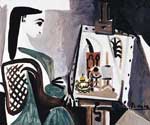VAM galleries including this work:
The Speed Art Museum | Art Through Time || VAM Home
Pablo Picasso (Spanish, 1881-1973)
WOMAN IN THE STUDIO, 1956
Oil on canvas; 18-1/16" X 21-9/16"
Bequest from the Nancy Batson Rash and the Dillman A. Rash Collection, 1998
© 1999 Estate of Pablo Picasso/Artists Rights Society (ARS), New York
The Speed Art Museum
This painting is one of a series that Pablo Picasso completed during the spring and early summer of 1956 at La Californie, his villa in Cannes. The woman is Jacqueline Roque (whom Picasso would marry a few years later), shown contemplating a painting on an easel in the artist’s studio. The forms of the figure and the surrounding interior have been simplified but not broken up or manipulated.
As in other depictions of Roque, Picasso has painted the figure in profile, her triangular eye fixated upon the artist’s work. She is depicted as an integral part of his creative process. Details such as the arch in the painting within the painting refer to the windows at La Californie and the palm trees beyond. The hatching near the sitter translates a wicker rocking chair that was a Picasso favorite, repeated countless times in 1956 and 1957 in drawings, ceramics, and paintings.
About the Artist
Pablo Picasso stands as the principal Modern artist of the 20th century. Over his long artistic career, he invented a good number of artistic styles on his own and dabbled in a number of others. Picasso became something of a cultural model for other Modern artists and even some contemporary artists—alternately charming and temperamental, very savvy of the media and his image, and ever evolving artistically.
Modernism/Modern Art refers to the overall art movement from the late 19th century to the early 1970s. While artists have always created works of art inspired by their own intellectual and emotional responses to the world around them, Modern artists were particularly concerned with their individual interpretive style and process. This focus on individual style and artistic process led many of them toward an abstracted use of the elements of art.
The new creative possibilities afforded by the cultural and social changes brought about by the Industrial Revolution encouraged artists to experiment with a number of new visual formats and ideas. As a reflection of this artistic diversity, Modernism can be considered as a larger heading under which a number of different art movements such as Impressionism, Fauvism, Expressionism, Cubism, Dada, Surrealism, and Abstract Expressionism all flourished in succession.
Modernism spans a period of great social upheaval and conflict, including such events as the two world wars, humankind’s trip to the moon, the development of nuclear technologies, and the Russian and Chinese revolutions. Technological developments such as photography surpassed the realism depicted in traditional works of art and made images of people and things more freely available. The discoveries of Albert Einstein fundamentally changed the conception of the physical world, and the work of Sigmund Freud altered the understanding of human emotions and internal motivations. Artists reacted to these events and developments, and the range of new artistic movements paralleled the great historical developments of the Modernist period.
Picasso played a role in almost every 20th-century movement. Over the course of his lifetime, he created some 22,000 works of art in a variety of media, including sculpture, ceramics, mosaics, stage design, and graphic arts.
Classroom Ideas
Discussion: Knowing that this work shows Picasso’s future wife and a painting in his studio, what do you think the artist is trying to portray? Is it important for Picasso to show us exactly how the scene looked, or does he have something else in mind? What could Picasso be trying to express?
Picasso once said, “I have tried all of my life to learn to draw like a child.” Why might Picasso have said that? (Children are more pure, children have fewer preconceived ideas, children’s art can be much more expressive, etc.) Do you think Picasso has effectively “drawn like a child” in this painting? Why or why not?
What shapes are used in this painting? Think of how these shapes are separated with line and color. Talk about using positive and negative space to create an abstract composition such as this.
What is your definition of abstraction? Compare it to the definition in the Arts Toolkit glossary. Compare abstraction to other painting approaches and styles. What can be expressed more effectively with abstraction than with a “realistic” approach?
Activities: Picasso’s work is usually described in terms of overlapping “periods.” They include
- the Post-Impressionist phase of his early career
- his Blue Period
- his Rose Period
- his Analytical Cubist Period
- his Synthetic Cubist Period
- his Neoclassical Period
- his Surrealistic Period
Compare and contrast Woman in the Studio with other works done by Picasso at different times of his life. Work in groups to research, make posters about, or create presentations on his wide range of work. Are there similarities or continuing themes found in works from different periods? Why do you think Picasso is considered one of the greatest artists of all time?
Choose one of the styles in which Picasso painted and create a painting in that style. As a class, work from the same subject matter (such as a still life) so that you can see the variety of interpretations.
Links
The official Picasso Administration site has images of numerous works, extensive biographical information, and critical essays.
[www.picasso.fr]
You’s find extensive links to more online artworks by Picasso in the Artcyclopedia.
[www.artcyclopedia.com/artists/picasso_pablo.html]
Read about the different periods in Picasso’s works in the Artchive.
[www.artchive.com/artchive/P/picasso.html]

